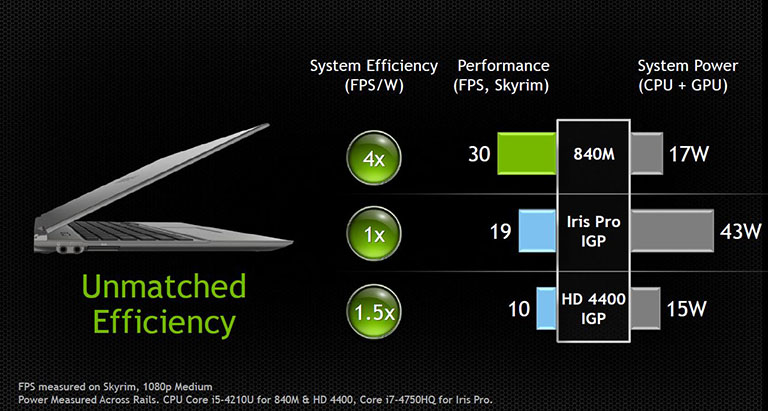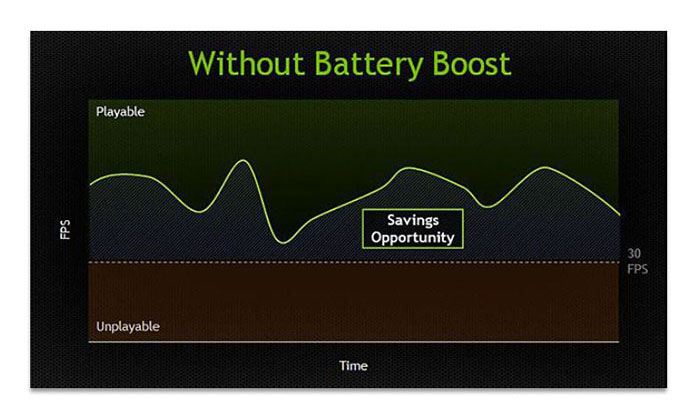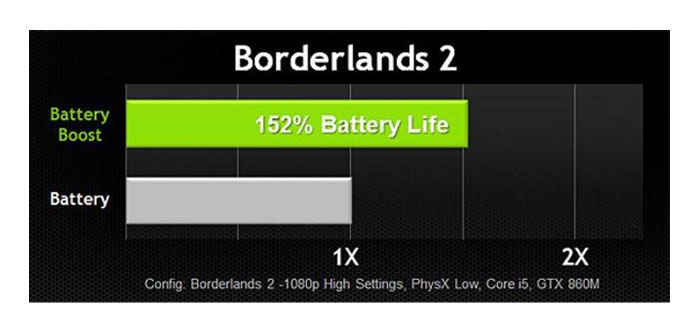Our Aim
To provide you with an overview on New And existing technologies, hopefully helping you understand the changes in the technology. Together with the overviews we hope to bring topical issues to light from a series of independent reviewers saving you the time And hassle of fact finding over the web.
We will over time provide you with quality content which you can browse and subscribe to at your leisure.
TekSpek 's

NVIDIA GeForce GTX 800M Mobile GPU
Date issued:
GeForce 820M, 830M and 840M
During March 2014, Nvidia revitalised its mobile GeForce product stack by introducing seven new 800M-series GPUs. Intended for ultra-thin notebooks all the way through to desktop-replacement machines, these new GPUs replace older 700M-class parts that shipped throughout 2013.
At the bottom of the pile nothing much has changed. Nvidia's 'new' 820M recycles the ageing Fermi architecture and is only short of being a total rebrand due to the slightly faster memory that is deployed.
Moving up to the GeForce 830M brings in the first glimpse of mobile Maxwell technology. While specifics haven't been revealed at the time of writing, these mobile GPUs are up to 35 per cent faster than previous-generation equivalents. More importantly for prospective notebook buyers is the fact the GeForce 840M is up to 4x faster than the HD 4400 graphics found in Intel's Core i5-4200U processor.

To prove it isn't playing any tricks with performance at the expense of power consumption Nvidia demonstrates that a notebook equipped with an Intel Core i5-4200U and a GeForce 840M uses a similar amount of power during gaming as a notebook running a Core i5-4200U with Intel HD 4400 graphics alone. Better still is the fact that configuration uses considerably less power than Intel's Core i7-4750HQ with Iris Pro Graphics while still delivering notably better performance.
The underlying message here is that Nvidia's newest discrete 800M graphics are both faster and more efficient than Intel's integrated graphics when gaming or performing other intensive 3D workloads. During idle periods, Nvidia's matured Optimus technology allows the notebook to switch over to Intel's HD graphics which are better equipped for handling basic graphical tasks with lower power consumption.
Performance mobile GTX graphics
Shifting the focus to Nvidia's performance GTX series, four new GPUs have been added - the GTX 850M, 860M, 870M and 880M. A mixture of Maxwell and Kepler microarchitectures are sprinkled across these offerings, with the lower-end 850M and 860M make use of Maxwell while the 870M and 880M remain Kepler-based.
Nvidia GeForce GTX Mobile Comparisons |
|||||||
|---|---|---|---|---|---|---|---|
| mGPU | Architecture |
Cores |
Frequency (MHz) |
Memory speed (MHz) |
Memory bus width (Bits) |
SLI |
Performance uplift (per cent) |
| GTX 880M | Kepler |
1,536 |
954+ |
5,000 |
256 |
Yes |
15 |
| GTX 780M | Kepler |
1,536 |
823 |
5,000 |
256 |
Yes |
- |
| GTX 870M | Kepler |
1,344 |
941+ |
5,000 |
192 |
Yes | 30 |
| GTX 770M | Kepler |
960 |
811 |
4,000 |
192 |
Yes |
- |
| GTX 860M | Maxwell |
640 |
1,029+ |
5,000 |
128 |
Yes | 40 |
| GTX 860M | Kepler |
1,152 |
797+ |
5,000 |
128 |
Yes | |
| GTX 760M | Kepler |
768 |
657 |
4,000 |
128 |
Yes |
- |
| GTX 850M | Maxwell |
640 |
936+ |
5,000 |
128 |
No |
60 |
GTX 750M | Kepler |
384 |
967 |
5,000 |
128 |
Yes |
- |
All of Nvidia's 8-series mobile graphics products have built-in GPU Boost technology allowing them to dynamically overclock depending on thermal and power conditions. The specific frequencies are not disclosed by Nvidia, presumably because the cooling solution deployed by each notebook vendor will affect the maximum attainable frequency.
The current 800M speed demon, the GTX 880M, is a higher-clocked version of the GTX 780M we saw last year. Nvidia says it has up to 15 per cent more performance with the help of GPU Boost technology, although the additional performance likely comes at a power consumption penalty given that the 880M is fundamentally the same design as the lower-clocked 780M. The GTX 870M, meanwhile, gets a larger boost in performance through a combination of frequency increases and extra processing cores. Nvidia claims 30 per cent move performance for the GTX 870M within the same sort of TDP range.
Two GTX 860M GPUs
One of the more interesting updates is the dual-architecture configuration of the GTX 860M. Available in either Kepler- or Maxwell-based varieties the 860M targets a wide variety of notebook models. The Kepler-based solution boasts 40 per cent more performance than the GTX 760M thanks to more processing cores and higher clock speeds. The Maxwell solution is touted to have a similar 40 per cent performance improvement compared to the GTX 760M, but with a modest 40W TDP - making it ideal for compact and lightweight notebooks. The Kepler-based GTX 860M has a 75W TDP meaning its a likely candidate for larger, less-portable gaming notebooks.
Maxwell gets a second outing with the GTX 850M. Using a similar formula of more cores and a high frequency the GTX 850M delivers a hefty 60 per cent performance upgrade compared to the last-gen GTX 750M. Placed in context the GTX 850M, designed for lightweight gaming notebooks, is as fast as the range-topping GTX 580M of three years ago. That's progress!
Battery Boost
Overcoming the restricted current and capacity of notebook batteries is something Nvidia addresses with the GeForce GTX 800M GPUs. The new technology in question, Battery Boost, alters the behaviour of mobile GTX GPUs depending on the power conditions. Typically mobile GPUs function their best when the notebook is plugged into the mains, offering a smooth experience with maximum performance potential. Once transitioned to the battery the story is often very different. Not only does performance decline with reduced current from the battery, but most mobile GPUs can easily empty a high-capacity battery in under a couple of hours.

Battery Boost is Nvidia's solution to the battery problem, and the term covers a wide range of the company's unique power-saving technologies. The primary method is frame-rate control, a process made transparent to the user. Through its GeForce Experience software Nvidia caps the frame-rate of on-battery gaming to 30FPS.
Nvidia claims there's more to Battery Boost that mere frame-rate capping, although such details are regarded as industry secrets. Nvidia is deliberately not revealing granular details about how it is able to reduce power consumption, only that Battery Boost uses driver-level governors and intelligent algorithms to identify excess power-consumption sources.
A possible method may include determining the extent to which a game is performance-bound and reducing power consumption of the relevant component. For example, if a game is CPU-bound then the GPU can be reduced in frequency and voltage with no great detriment to performance.
Since Battery Boost technology is baked-in to the Nvidia driver the end-user can have full flexibility over how the new tech interacts with their specific setup. Target frame-rates and image-quality settings can be designated within the Nvidia control panel. The actual power savings realised by activating Battery Boost will vary from title to title, according to Nvidia. Intensive titles like Crysis 3 may reveal minimal battery-life gain as the GPU gets hit hard trying to run 30FPS regardless, but less intensive titles such as League of Legends may show more overall benefit as the frame-rate reduction is larger.

Up to 2x the gaming time
With the results of its own internal testing at hand Nvidia claims that a standard gaming notebook making use of Battery Boost can witness a 50 per cent increase in mobile battery life for semi-GPU-intensive titles, rising to as much as 100 per cent in less-intensive titles like the aforementioned League of Legends.
Considering Battery Boost is only a first-generation mobile technology it is easy to see how it holds genuine real-world potential for the future. Such a technology might even be extended to notebook displays alongside G-Sync, allowing the display to adjust its refresh rate to match the Battery Boost targets and save even more power.
Appreciating that GeForce 800M-class GPUs provide more gaming performance and greater battery run-time, Scan Computers has quickly transitioned its range of notebooks to these mobile processors. Please head on over to here to see exactly what Scan has to offer.